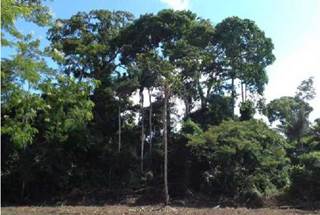The species of the genus Theobroma L. have special importance for their conventional or potential uses and they represent possible sources of genetic resistance for other more economically important species such as T. cacao L. (Silva, et al., 2011; Dardengo, et al., 2016).
All Amazonian cacao species are found in the "terra firme" rainforest sub-type or areas periodically flooded by rivers and lakes, the so-called "várzea"; in the latter, they preferably occupy the sections that are rarely or little flooded. On the "terra fime", most of these species prefer banks of streams and other humid places, but T. speciosum Willd. ex Spreng inhabits relatively dry land (Ducke, 1953).
The bark of T. speciosum fruits is associated with the wood fawn generates a deodorant used by Amazonian populations (Dardengo, et al., 2016; Di Stasi and Hiruma-Lima, 2002). Balée (1994) and Dewalt, et al. (1999) indicated that the fruit is also a source of nutrients for the Ka'apor indigenous people in the Amazon region of Brazil and the Tacana region of Bolivia.
Among the plants of the genus Theobroma present in Brazil, we find a species commonly known as "cacauí" (T. speciosum). This species grows in an area extending from the states of Maranhao to Cururupu in Acre and Madre de Dios in western Bolivia and the Ucayali River in Perú (Cuatrecasas, 1964). Silva and Martins (2009) indicated that the dispersing agents of T. speciosum are unknown. According to Bates (1979), the aggregate distribution of T. cacao is due to the dispersion by monkey species. The monkey Sapajus paella (Linnaeus, 1758), which transports more fruits than it eats, promotes colonization in other habitats, as well as Saimiri scireus (Linnaeus, 1758), which feeds on the tree that produces the fruits. In this context, our aim was to report the first records of dispersing species of T. speciosum.
Our study took place in a one-hectare fragment of forest in east Amazonia (3°24'42.7' S, 51° 51'50.7' W) during March 2017 (Figure 1). The study area is part of the Amazon forest biome and is mainly covered by a mosaic of: 1) Dense ombrophilous forest fragments where species such as the Brazil nuts (Bertolletia excelsa Humn. & Bonpl.) and the jatobá (Himenea courbaril L.) dominate in the upper canopy and a mosaic between the dense and open forest where the woody lianas (Schnella sp.) predominate. The medium stratum is dominated by T. speciosum and Inga sp. 2, cacao plantations, and herbaceous vegetation with Brachiaria grass. According to the Köppen classification, the climate is type Am with an average temperature of 26°C, annual rainfall of 2,289 mm, and relative humidity between 78 and 88% (Sousa Jr., et al., 2006).
To establish the identity of the fruit disperses, we placed a Sony®Cyber-shot camera in front of a fructifying tree fixed to another different tree at a height of 1.6 m from the ground for five days totaling an effort of 50 camera-trap nights.
During the observation period, we observed dispersion in larger spaces by S. paella and by Mico argentatus (Linnaeus 1766) and G. aestuans in short distances (https://youtu.be/xK7p99rwi0A, https://youtu.be/VWjiaPy2EbQ, https://youtu.be/QoGcQyhpH44). It is worth noting that it was not possible to follow the opening of the fruit. According to residents, the fruit is gnawed at night by the South American spiny rats (Proechimys sp. Allen 1899). In recent observations in the Forest Manajement Unit Fazenda Uberlândia (near 3°0'41" S; 50°5'19"W), we observed intense movement of Proechimys in a fructifying tree of T. speciosum during the night.
We found that in the region of the Volta grade do Xingu, T. speciosum is dispersed by S. apella. This monkey species carries more fruits than it eats. We also observed the small monkey M. argentatus and the rodent G. aestuans feeding on the site but at different times as indicated by Bates (1979) for Saimiri sciureus.
Theobroma speciosum is an important species for humans (Di Stasi & Hiruma-Lima, 2002; Dardengo, et al., 2016; Balée, 1994; Dewalt, et al., 1999) and wildlife because it provides fruits to rodents and primates. It is also of great potential as it can serve as a source of genetic variability for related species such as T. cacao that are exploited economically (Dardengo, et al., 2016).
Considering that it has been reported that T. cacao seeds are dispersed by S. apella and S. sciureus (Cuatrecasas, 1964), Silva and Martins (2009) have suggested that the very similar seeds of the domesticated congeneric species T. speciosum could be dispersed by the same animal species generating a typically aggregated spatial pattern of plants distribution. Besides, these authors argue that this type of distribution allowed the pollination by Drosophila. On the other hand, the study by Dardengo, et al. (2016) with microsatellite markers indicated inbreeding and genetic substructure in a population of T. speciosum in southern Amazonia. The latter was evidenced partially by the distribution pattern of individuals given that T. speciosum is considered a self-incompatible species (Souza & Venturieri, 2010).
Thus, our data reinforced those in scattered records and showed the importance of understanding the dispersion, pollination, and genetic structure of this tree species for the planning conservation strategies of wild species with potential for the industry, biotechnology, and forest people's maintenance.















